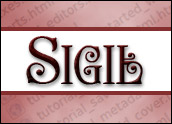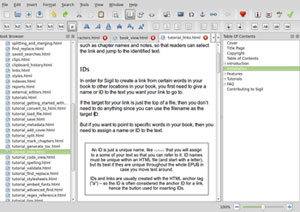
![]()
If you package e-books in the EPUB format, one of the handiest editing tools available is Sigil.
The growing interest in mobile apps and e-reader devices such as Amazon’s Kindle and Barnes & Noble’s Nook is fueling the e-book business for both reading consumers and authors. Without a dedicated editing tool such as the Sigil E-Book Editor, setting up the embedded HTML coding and editing an e-book manuscript is often fraught with frustration and formatting errors.
Sigil, released under the GNU GPL v3 license, takes a WYSIWYG approach to this process. Its developers — lead developer and maintainer John Schembe, along with Grant Drake and Dave Heiland — include a comprehensive user manual in the .epub file format that serves as an excellent working example of how to use the e-book editor. Strahinja Markovic originally created Sigil in 2009.
With the WYSIWYG editing feature, you create or edit text the same way you would work in a high-end text editor or word processor. Sigil embeds the required formatting codes, but hides them while you work. A direct code editing mode is available for advanced users.
Editing, Not Creating
Sigil may not be the best choice for creating an e-book from scratch. I do not say that as a criticism. You can use it to start writing an e-book. However, it is not Sigil’s purpose.
Sigil is primarily an editing program for content already written in a word processor or text editor. Ideally, you create the content first and then export it to HTML format, which is the basis of the EPUB file format. Then employ Sigil to edit and format it for EPUB distribution.
That said, I have used Sigil to create from scratch small e-books for some projects, instead of keeping them in .doc or .PDF formats. Depending on the viewing method or e-book device, Sigil’s creation results are acceptable if I take the time to check how the file displays in various devices and make adjustments.
As an e-book editing tool, however, Sigil really excels. I especially like its built-in error checker. In Sigil’s Tools menu, select the option to validate the EPUB format with FlightCrew. It provides a list of errors to fix. The Tools menu also has an option to validate the style sheets.
What It Does
The EPUB format is a file containing words, images, a table of contents, style sheets and fonts stored together using the common zip format. This format is read by various e-reader devices and easily converts to other formats. Sigil, however, does not convert to other formats. It also only reads text files and HTML files natively.
Much like using a word processor, Sigil’s user interface lets you insert headings, specify fonts, add numbered or bulleted lists, images, video, Internet links and other graphic treatments. The beauty of Sigil is you can do these tasks without knowing HTML coding.
If you use the advanced mode, however, then you begin to learn HTML codes. This gives you the ability to refine the appearance of the ebook.
When you finish creating an ebook or editing an existing manuscript, Sigil automatically generates a Table Of Contents based on the headings used throughout the manuscript. Sigil’s features include integrated spell checking, metadata editing, ebook content reports and a built-in clip manager.
Good GUI
I like Sigil’s user interface. It is intuitive and thus easy to use. I was able to start editing a practice file immediately without pouring through an instructional guide. However, the user manual is a great way to learn how Sigil works.
Sigil’s user interface uses a divided viewing panel that relies on tabbed pages and different viewing windows. The upper section of the display looks like any high-end word processor or text editor. It has the drop-down menu row. Under that are two rows of icons and text formatting tools.
The Main Menu row has most of the available commands. The movable Toolbar Buttons provide quick access to many menu items. Keyboard Shortcuts identified in the drop-down menus are user-definable for all menu items. Right-click Context Menus offer quick access to editing features.
Highly Usable
The bottom of the display shows error messages and other reports depending on which features you access. The center portion of the application window is split into three viewing panels.
The left panel, called Book Browser, lists each section of the text. Clicking on any spot jumps instantly to that text area displayed in the center or second panel. The third or right side panel displays the accumulating Table of Contents.
Each time you click on a location in the Book Browser, it opens into a tab in the center display; moving back and forth to different parts of the e-book’s content is a simple click on a tab.
The View menu lets you change the type of display visible in the center panel. The choices are: Book View, which hides all format coding; Preview, which shows the plain text view in a split window and the coding and style sheets in a shared window under it; and Code View, which shows the text with HTML codes visible.
Editing Delights
Sigil is loaded with lots of useful editing features. For instance, proofreaders will appreciate the “Next misspelled word” command with a handy Ctrl+Shift+V shortcut for it. A neat navigational features lets you click through next and previous open tabs in the main display panel.
The Reports Dialog shows an overview of manuscript length in words and the number of misspelled words for each chapter file. It also tells you how large your images are in kilobytes and pixels, as well as which elements each chapter files uses, and in which CSS files those elements are described.
Two other cool tricks involve how Sigil handles style sheets and Index editing. For example, it removes unused images and CSS files. It also reformats the contents of the CSS files depending on your preferences for single-line or multi-line selectors.
Sigil’s Index Editor gives several options for making complex indexes. For instance, you can make groups for an alphabet-based index, or use regular expressions for matching the text. A third choice is merging synonyms into a single index entry.
Bottom Line
Sigil is a solid tool for working with the EPUB format for ebooks. It is available in versions for Linux .deb-based distros as well as Windows and Mac PCs. I reviewed the latest Linux version — 0.6.2, which worked fine on both Linux Mint 14 and Ubuntu 12.10. However, I could not find it available through either distro’s package management repositories. Sigil is available in versions 0.7.1 for the other two platforms.
This is a very capable editor for EPUB formatted e-books. It is also acceptable, but not great, for creating the text of an e-book because it lacks other writing features. If you do not mind figuring out your own workarounds to create first drafts of e-books, Sigil can be a very satisfying double-duty e-book tool.
Want to Suggest a Linux Application for Review?
Is there a Linux software application you’d like to suggest for review? Something you love or would like to get to know?
Please send your ideas to me at [email protected] and I’ll consider them for a future Linux Picks and Pans column.
And use the Talkback feature below to add your comments!





















































